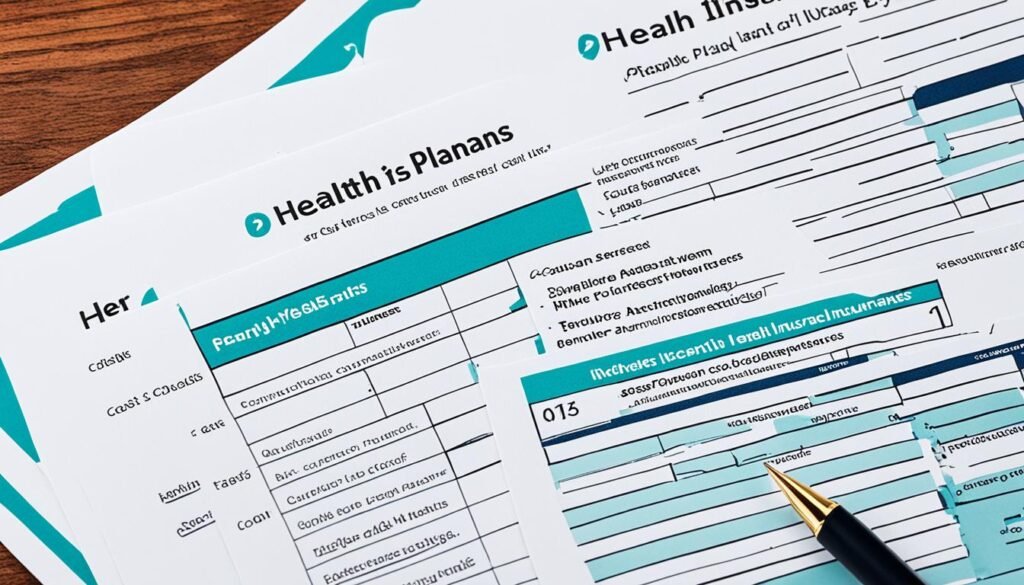Health insurance is an essential aspect of managing healthcare needs and expenses. It provides financial protection and access to quality medical services. However, understanding health insurance plans can be overwhelming for many individuals. That’s why we have created this comprehensive guide to help you navigate through the intricacies of health insurance.
In this guide, we will provide you with valuable information on the basics of health insurance, the various types of plans available, key terms to be aware of, and how to choose the right plan that suits your specific needs. Whether you are new to health insurance or seeking to switch plans, this guide will equip you with the knowledge necessary to make informed decisions.
Key Takeaways:
- Understanding health insurance is crucial for managing healthcare expenses and accessing necessary medical services.
- There are various types of health insurance plans, including HMO, PPO, EPO, and POS, each with its own features and benefits.
- Familiarizing yourself with key terms such as premiums, deductibles, copayments, coinsurance, and out-of-pocket maximums is essential for understanding how health insurance coverage works.
- Choosing the right health insurance plan involves assessing your healthcare needs, comparing plan options, and considering additional benefits that align with your preferences and budget.
- Maximizing your health insurance benefits requires understanding plan rules, utilizing in-network providers, accessing preventive services, managing chronic conditions effectively, keeping records, appealing denied claims, and regularly reviewing your plan.
The Basics of Health Insurance
Health insurance plays a vital role in managing healthcare expenses and ensuring proper coverage. Understanding the fundamentals of health insurance is essential for making informed decisions about your healthcare needs. In this section, we will delve into the basics of health insurance, including what it entails, the types of coverage available, and the various healthcare expenses that can be covered.
What is Health Insurance?
Health insurance is a contractual agreement between individuals and insurance providers. Under this agreement, the insurer agrees to cover a portion of healthcare expenses in exchange for regular premium payments. By having health insurance, individuals gain access to a wide range of medical services and treatments, even if they cannot afford to pay for them out-of-pocket.
The coverage provided by health insurance can vary depending on the specific plan and its terms. However, most health insurance plans typically cover essential services such as doctor visits, hospitalizations, prescription medications, and preventive care.
Types of Coverage
Health insurance plans offer different types of coverage, each with its own set of benefits and limitations. Common types of coverage include:
- Medical Coverage: This type of coverage includes services provided by healthcare professionals, such as doctor visits, specialist consultations, surgeries, and hospitalizations.
- Prescription Drug Coverage: This coverage ensures that prescription medications are included in the insurance plan, making them more affordable for individuals.
- Mental Health Coverage: Mental health services, including therapy and counseling, are often included in health insurance plans to support overall well-being.
- Dental Coverage: Some health insurance plans also offer dental coverage, which includes regular check-ups, cleanings, and necessary dental procedures.
- Vision Coverage: Vision coverage typically includes annual eye exams, prescription glasses, and contact lenses.
Covered Healthcare Expenses
Health insurance can help cover a wide range of healthcare expenses, ensuring that individuals receive the necessary medical care without incurring excessive costs. Some of the common healthcare expenses that can be covered by health insurance include:
- Doctor visits and consultations
- Hospital stays and surgeries
- Prescription medications
- Diagnostic tests and laboratory services
- Emergency room visits
- Preventive services such as vaccinations and screenings
- Mental health and substance abuse treatment
It is important to note that coverage and reimbursement for healthcare expenses may vary depending on the specific health insurance plan. It is crucial to carefully review the plan’s terms and conditions to ensure that the desired healthcare services are covered.
Now that we have covered the basics of health insurance, we can move on to exploring the different types of health insurance plans available. It’s essential to understand these options to find the right plan that meets your specific healthcare needs and financial situation.
Types of Health Insurance Plans

When it comes to health insurance, understanding the different plan types is crucial in finding the right coverage for your needs. The most common types of health insurance plans include Health Maintenance Organization (HMO), Preferred Provider Organization (PPO), Exclusive Provider Organization (EPO), and Point of Service (POS) plans.
HMO (Health Maintenance Organization) Plan
An HMO plan typically requires you to choose a primary care physician (PCP) who acts as your main point of contact for all your healthcare needs. Under this plan, you must receive care from healthcare providers and facilities within the HMO network, with limited coverage for out-of-network services. HMO plans often have lower premiums and deductibles, but you may need a referral from your PCP to see a specialist.
PPO (Preferred Provider Organization) Plan
A PPO plan offers more flexibility in choosing healthcare providers. You have the freedom to receive care from both in-network and out-of-network providers, although the latter may result in higher out-of-pocket costs. With a PPO plan, you don’t need a referral to see a specialist, allowing for a more direct approach to accessing specialized care. However, PPO plans generally have higher premiums and deductibles compared to HMO plans.
EPO (Exclusive Provider Organization) Plan
An EPO plan combines elements of both HMO and PPO plans. Like an HMO, an EPO plan requires you to stay within the network for coverage, providing limited coverage for out-of-network services, except in emergencies. However, similar to a PPO, you can often see specialists without a referral. EPO plans generally have lower premiums and deductibles compared to PPO plans, making them an affordable choice for individuals who prefer a more restricted network.
POS (Point of Service) Plan
A POS plan is a hybrid of an HMO and PPO plan. It requires you to choose a PCP and obtain referrals for specialist care, similar to an HMO. However, you have the option to receive care outside the network by paying higher out-of-pocket costs, resembling a PPO plan. POS plans usually have lower premiums than PPO plans but higher premiums than HMO plans.
Understanding the different health insurance plan types is essential for making an informed decision. Take into account factors such as your healthcare needs, budget, and preferred level of flexibility when choosing the right plan that aligns with your lifestyle and requirements.
Key Health Insurance Terms

Understanding health insurance can be overwhelming without knowledge of key terms. In this section, we will explain the most important health insurance terms that will help you navigate your coverage effectively.
Premium
The premium is the amount of money you pay to your health insurance provider for coverage. It can be paid monthly, quarterly, or annually. Think of it as a membership fee that allows you to access healthcare services.
Deductible
A deductible is the amount you must pay out of pocket for healthcare services before your insurance coverage kicks in. For example, if your deductible is $1,000, you’ll have to pay the first $1,000 of your medical expenses before your insurance starts covering a portion of the costs.
Copayment
A copayment is a fixed amount you pay for a specific healthcare service after you’ve met your deductible. It’s typically a smaller amount, such as $20 or $30, and is paid at the time of service. Copayments are common for doctor visits or prescriptions.
Coinsurance
Coinsurance is the percentage of costs you share with your insurance provider after you’ve met your deductible. For example, if your coinsurance is 20% and your medical bill is $100, you would be responsible for paying $20 while your insurance covers the remaining $80.
Out-of-Pocket Maximum
The out-of-pocket maximum is the maximum amount you will pay for covered healthcare services in a given year. Once you reach this limit, your insurance will cover 100% of your eligible expenses, providing financial protection from excessive medical costs.
Understanding these health insurance terms will help you make informed decisions about your coverage and manage your healthcare expenses effectively.
Choosing the Right Health Insurance Plan

When it comes to choosing a health insurance plan, it’s essential to assess your healthcare needs, compare plan options, and consider personal preferences. By following these steps, you can make an informed decision that provides the coverage you need while staying within your budget.
Assessing Your Healthcare Needs
The first step in choosing the right health insurance plan is to evaluate your healthcare needs. Consider factors such as:
- Current health conditions
- Prescription medications
- Frequency of doctor visits
- Anticipated healthcare needs
By understanding your specific healthcare requirements, you can identify the features and benefits that are most important to you.
Comparing Plan Options
Once you have a clear understanding of your healthcare needs, it’s time to compare different plan options. Look for plans that:
- Cover the healthcare services and specialists you require
- Have a network of hospitals and doctors that is convenient for you
- Offer reasonable premiums, deductibles, and co-pays
- Provide additional benefits such as dental or vision coverage
Comparing these factors will help you narrow down your options and find a plan that fits your requirements and budget.
Considering Additional Benefits
While cost and coverage are essential, don’t forget to consider additional benefits when choosing a health insurance plan. Some plans offer features such as:
- Wellness programs and preventive care coverage
- Telehealth services for virtual doctor consultations
- Access to discounted gym memberships or wellness services
These extras can enhance your overall healthcare experience and contribute to your well-being.
| Plan Option | Premium | Deductible | Co-Pays |
|---|---|---|---|
| HMO | Low | Fixed | Low |
| PPO | Medium | Variable | Medium |
| EPO | Low | Fixed | Variable |
| POS | Medium | Variable | Variable |
Use the table above to compare common plan options based on premium levels, deductibles, and co-pays. This will give you a clear visual representation of the different costs associated with each plan.
By carefully assessing your healthcare needs, comparing plan options, and considering additional benefits, you can confidently choose the health insurance plan that best suits your unique circumstances. Remember, having the right coverage is an important step towards maintaining your well-being and financial security.
Maximizing Your Health Insurance Benefits

Simply having health insurance is not enough; knowing how to maximize the benefits is crucial. By understanding the ins and outs of your health insurance plan, you can make the most of your coverage and take advantage of the available resources to support your health and well-being.
Understanding Plan Rules
One of the first steps to maximizing your health insurance benefits is familiarizing yourself with the rules and guidelines of your specific plan. Each health insurance plan has its own set of rules regarding in-network providers, coverage for preventive services, and procedures for filing claims.
Take the time to review your policy documents or contact your insurance provider for clarification on any confusing terms or coverage details. Being well-informed about your plan can help you avoid unexpected out-of-pocket expenses and ensure that you fully leverage the benefits available to you.
Utilizing In-Network Healthcare Providers
Staying in-network is an essential aspect of maximizing your health insurance benefits. In-network providers have negotiated rates with your insurance company, meaning that they have agreed to charge lower fees for services. By utilizing in-network providers, you can minimize your out-of-pocket costs and maximize the value of your insurance coverage.
Before scheduling appointments or undergoing medical procedures, always check to see if the healthcare providers you plan to visit are in-network. Your insurance company’s website or customer service department can provide you with a list of in-network providers in your area. Doing so will help you avoid surprise charges and ensure that you are receiving the highest level of coverage.
Using Preventive Services
Many health insurance plans offer coverage for preventive services at no additional cost to the insured. Taking advantage of these services can help you maintain good health, catch potential issues early on, and prevent more serious health problems in the future.
Preventive services may include routine check-ups, vaccinations, screenings, and counseling for tobacco cessation, weight management, and other lifestyle changes. These services are designed to promote overall wellness and keep you healthy. Be sure to check your plan documents for a complete list of covered preventive services and schedule regular appointments as recommended.
Managing Chronic Conditions Effectively
If you have a chronic condition, such as diabetes or asthma, effectively managing your health can help you optimize your health insurance benefits. Regularly monitoring your condition, taking prescribed medications as directed, and following recommended treatment plans can prevent complications and reduce the need for costly medical interventions.
Work closely with your healthcare provider to create an individualized care plan that aligns with your health insurance coverage. Educate yourself about your condition and available resources, such as support groups and educational materials, to stay proactive in your health management.
Keeping Records and Appealing Denied Claims
Keeping detailed records of your medical expenses, including bills, receipts, and insurance claims, is essential for maximizing your benefits. These records can help you track your healthcare expenses, ensure that you receive appropriate coverage, and make the claims process smoother.
In the event that your health insurance claim is denied, don’t be afraid to appeal the decision. Insurance companies may sometimes make errors or overlook certain aspects of coverage. By providing additional documentation or seeking assistance from your healthcare provider, you may be able to successfully appeal the denial and receive the benefits you are entitled to.
Reviewing the Plan Annually
Health insurance plans can change from year to year, including adjustments to coverage, premiums, and provider networks. To ensure that you are still getting the best value for your money, it’s important to review your plan annually during the open enrollment period.
During this time, carefully evaluate your healthcare needs, review plan options, and consider any changes in your circumstances that may impact your coverage requirements. Research and compare different plans to find one that aligns with your specific needs and offers the most comprehensive coverage at an affordable price.
By following these tips and making the most of your health insurance benefits, you can take control of your healthcare and confidently navigate the complexities of the system.
Understanding the Impacts of the Affordable Care Act

The Affordable Care Act (ACA), also known as Obamacare, has revolutionized health insurance coverage in the United States. This section explores the key areas where the ACA has made a significant impact, ensuring affordable and accessible healthcare for millions of Americans.
Essential Services
One of the major changes brought by the Affordable Care Act is the requirement for health insurance plans to cover essential health benefits. These benefits include preventive services, prescription drugs, maternity care, mental health services, and more, ensuring that individuals have access to essential medical care without facing exorbitant costs.
Individual Mandate
In an effort to promote widespread insurance coverage, the ACA introduced the individual mandate. This provision required individuals to have health insurance or pay a penalty. By expanding the risk pool and encouraging healthier individuals to enroll, the individual mandate aimed to stabilize insurance markets and reduce healthcare costs for everyone.
Enrollment Periods
The Affordable Care Act established specific enrollment periods during which individuals can sign up for health insurance coverage. These designated periods ensure that everyone has an opportunity to obtain coverage and prevents insurers from denying coverage based on pre-existing conditions. Open enrollment typically occurs once a year, while special enrollment periods allow individuals to sign up outside of the designated timeframe due to specific life events.
The Health Insurance Marketplace
The ACA introduced the health insurance marketplace, an online platform where individuals and small businesses can compare and purchase health insurance plans. The marketplace offers transparency, allowing consumers to easily understand plan details, costs, and coverage options. It provides a centralized location for individuals to access subsidies and other financial assistance to make health insurance more affordable.
The Affordable Care Act has undoubtedly shaped the landscape of health insurance coverage in the United States. By expanding essential services, implementing the individual mandate, establishing enrollment periods, and creating the health insurance marketplace, the ACA has increased access to affordable healthcare for millions of Americans.
The Complexity of the American Health Insurance System

The American health insurance system is known for its complexities, presenting challenges for individuals seeking coverage. To truly understand its strengths and weaknesses, it is essential to examine various aspects, including access to healthcare services, international comparisons, and the advantages and disadvantages of the U.S. system.
When it comes to access, the American health insurance system faces significant hurdles. While the system aims to provide coverage for individuals, there are still many who remain uninsured or underinsured. This lack of coverage can result in limited access to necessary healthcare services, creating barriers to preventive care, treatment, and overall well-being.
Compared to healthcare systems in other countries, the American health insurance system stands out for its complexities. Many developed nations have adopted universal healthcare systems, providing comprehensive coverage to all citizens. In contrast, the U.S. system relies on a mix of public and private insurance plans, which can lead to disparities in coverage and healthcare outcomes.
“The American health insurance system is characterized by its complexities, making it a challenge for individuals to navigate and obtain the necessary coverage for their healthcare needs.” – Dr. Emily Johnson, Healthcare Policy Expert
Despite its complexities, the American health insurance system does have its strengths. Private insurance plans offer a range of options, allowing individuals to select plans that align with their specific healthcare needs and budget. Additionally, competition among insurance providers can drive innovation and offer a variety of coverage options.
However, the U.S. system also has its weaknesses. Affordability remains a key concern, with rising healthcare costs burdening individuals and families. Moreover, the system’s emphasis on profit margins can sometimes result in limited coverage, exclusions, and challenges in accessing necessary treatments and medications.
The Advantages of the American Health Insurance System
- Private insurance plans offer a diverse range of options to cater to individual needs.
- Competitive market forces can drive innovation and improve coverage offerings.
- Employer-sponsored health insurance provides coverage for many Americans.
The Disadvantages of the American Health Insurance System
- Rising healthcare costs pose challenges for individuals and families.
- Limited access to healthcare services for the uninsured and underinsured.
- Complexities in plan selection, terms, and coverage can be overwhelming for consumers.
The American health insurance system is a complex web of coverage options, regulations, and financial considerations. While it offers a range of choices and promotes competition, it also presents challenges that may hinder access to quality healthcare. Understanding its intricacies is crucial for individuals to make informed decisions and advocate for improvements in the system.
Fixing the Broken Healthcare System

The American healthcare system is in dire need of reform. It is plagued by problems such as limited access, exorbitant costs, and an overemphasis on treating illnesses rather than preventing them. To address these issues and build a more efficient and equitable healthcare system, it is essential to focus on four key areas: fixing the healthcare system itself, ensuring affordable universal access, promoting wellness and prevention, and addressing pricing practices that have led to skyrocketing healthcare costs.
One of the primary objectives in fixing the healthcare system is to improve its efficiency and effectiveness. This can be achieved by streamlining administrative processes, reducing bureaucracy, and promoting interoperability among healthcare providers and insurers. By eliminating unnecessary red tape and ensuring seamless communication, healthcare providers can optimize care delivery, leading to better outcomes for patients.
Achieving affordable universal access is another vital aspect of healthcare reform. Everyone, regardless of their socioeconomic status, should have access to quality healthcare services when needed. This can be accomplished through a combination of measures, including expanding Medicaid, implementing state-based reinsurance programs, and exploring innovative models such as universal healthcare coverage. By ensuring that no one is left behind, we can create a more inclusive and compassionate healthcare system.
Wellness and prevention must also take center stage in healthcare reform efforts. By shifting the focus from reactive treatment to proactive prevention, we can significantly reduce the burden of chronic illnesses and improve overall population health. A comprehensive approach that includes promoting healthy lifestyles, early detection, and regular screenings can help individuals stay healthier and prevent costly diseases down the line.
Addressing pricing practices is crucial for making healthcare more affordable and sustainable. The current pricing structure in the United States is opaque and often leads to inflated costs for medical services, medications, and insurance premiums. Implementing price transparency measures, encouraging competition among healthcare providers and insurers, and exploring alternative payment models such as value-based care can help rein in healthcare costs and ensure that healthcare remains accessible to all.
“Fixing the broken healthcare system requires a comprehensive approach that tackles both the structural and systemic issues plaguing the industry. By focusing on affordable universal access, wellness and prevention, and fair pricing practices, we can create a healthcare system that provides high-quality care for all Americans.”
Key Recommendations for Fixing the Healthcare System:
- Streamline administrative processes and promote interoperability among healthcare providers and insurers.
- Expand Medicaid and implement state-based reinsurance programs for affordable universal access.
- Promote wellness and prevention through healthy lifestyle initiatives and regular screenings.
- Implement price transparency measures and encourage competition among healthcare providers and insurers.
- Explore alternative payment models such as value-based care to control healthcare costs.
Comparing Health Insurance Systems

Understanding the American health insurance system requires comparing it to those of other developed nations. Let’s take a closer look at healthcare systems around the world and how they stack up against the U.S. system.
Healthcare Systems in Developed Nations
Developed nations prioritize accessible and affordable healthcare for their citizens. Countries such as Canada, Germany, Australia, and the United Kingdom have implemented universal healthcare systems that provide coverage to all residents. These systems are often funded through taxes and offer comprehensive medical services.
In Canada, for example, residents have access to free healthcare services and can choose their own healthcare providers. Germany’s healthcare system combines public and private insurance, providing coverage for the whole population.
While each system has its unique features, they share the common goal of ensuring that all residents have access to quality healthcare. These systems often provide preventive care, mental health services, and chronic disease management as part of their coverage.
Comparing the U.S. System
The U.S. health insurance system differs from those of many developed nations. Unlike countries with universal healthcare, the U.S. relies primarily on private insurance providers, employers, and government-funded programs like Medicare and Medicaid.
The U.S. system offers a wide range of insurance options, including employer-sponsored plans, individual plans, and government programs for eligible populations. However, not all Americans have access to affordable coverage, and the cost of healthcare can be a significant burden for many.
One of the key differences between the U.S. system and those of other developed nations is the level of coverage and out-of-pocket expenses. In some countries, healthcare services are fully covered, with minimal or no copayments or deductibles. In the U.S., patients often face high deductibles, copayments, and coinsurance, leading to significant out-of-pocket costs.
Strengths and Weaknesses
Each healthcare system has its strengths and weaknesses. While the U.S. system offers a wide variety of insurance options and innovative medical technologies, it struggles with issues of affordability, access, and equitable coverage.
On the other hand, universal healthcare systems provide coverage for all residents, promoting equitable access to healthcare. However, these systems may face challenges related to long wait times for certain procedures and limited options for specialized care.
It’s important to note that healthcare systems are complex, and what works in one country may not be directly applicable to another. Nevertheless, studying and comparing different systems can provide valuable insights and potential solutions for improving the American health insurance system.
| Comparison | Developed Nations | U.S. System |
|---|---|---|
| Primary Funding | Tax-funded | Private insurance, employers, government programs |
| Coverage | Universal | Varies; not all have affordable coverage |
| Out-of-Pocket Expenses | Minimal or none | Significant; high deductibles, copayments, coinsurance |
| Strengths | Equitable access, comprehensive coverage | Wide variety of insurance options, innovative technologies |
| Weaknesses | Long wait times, limited specialized care options | Affordability, access, equitable coverage |
Comparing healthcare systems helps us learn from various approaches and identify potential areas for improvement. While no system is perfect, understanding these differences can inform discussions on how to enhance the American health insurance system and ensure that all individuals have access to affordable, quality healthcare.
Also Read: 10 Unknown Facts About Bike Insurance
Conclusion
Navigating health insurance can be a complex and overwhelming task, but it is an essential aspect of managing healthcare costs and maintaining overall well-being. By understanding the basics of health insurance, comparing plan options, and maximizing the benefits offered, individuals can make informed decisions that ensure financial security and access to necessary healthcare services.
Health insurance provides a safety net that protects individuals and families from the financial burden of unexpected medical expenses. It allows for timely access to healthcare services, preventive care, and essential treatments without incurring exorbitant costs. By having health insurance coverage, individuals can proactively address their healthcare needs and prioritize their well-being.
However, it is crucial to use health insurance wisely. By staying informed about plan rules, utilizing in-network healthcare providers, and taking advantage of preventive services, individuals can effectively manage their healthcare costs and maintain their well-being. Regularly reviewing the insurance plan, understanding covered services, and keeping records of medical expenses can further help individuals stay in control of their healthcare finances and make informed decisions.
FAQs
Q: What is Medicare and how does it fit into health insurance plans?
A: Medicare is a federal health insurance program primarily for individuals over 65 or with certain disabilities. It is one of the available health insurance options depending on your stage of life.
Q: How do I pick a health insurance plan that best suits my needs?
A: When choosing a health plan, consider your health needs, financial situation, and the benefits offered by each plan. It’s important to pick a health insurance plan that aligns with your individual health requirements.
Q: What are the different types of health insurance plans available for families?
A: Family plans are offered by various insurance companies and can include coverage for family members under a single policy. These family health insurance plans cater to the health needs of the entire family.
Q: What are marketplace plans and how do they help in finding the right health insurance?
A: Marketplace plans are health plans available through the Health Insurance Marketplace. They offer a range of options for individuals and families, helping you find a plan that suits your specific health requirements.
Q: Are there health insurance plans designed for every stage of life?
A: Yes, there are health insurance plans tailored to every stage of life, from individual health plans for young adults to family plans for those with dependents. It’s important to choose a plan that aligns with your current life stage.
Q: What are the benefits of choosing a health insurance plan from a reputable life insurance company?
A: Opting for a health insurance plan from a reputable life insurance company can provide you with a comprehensive range of products and services, along with the assurance of dealing with a trusted legal entity.
Q: How do I navigate the nuances of different health coverage options in family insurance plans?
A: Understanding the details of health coverage in family insurance plans is crucial. Make sure to review the policies and health benefit plans offered by different insurers to determine which plan best fits your needs.
Source Links
- https://www.jblearning.com/catalog/productdetails/9781284113129
- https://www.linkedin.com/pulse/navigating-health-insurance-comprehensive-guide-rahmani-
- https://amplifypublishinggroup.com/product/nonfiction/politics-and-current-affairs/realclear-publishing/the-healthcare-labyrinth-a-guide-to-navigating-health-plans-and-fixing-american-health-insurance/




